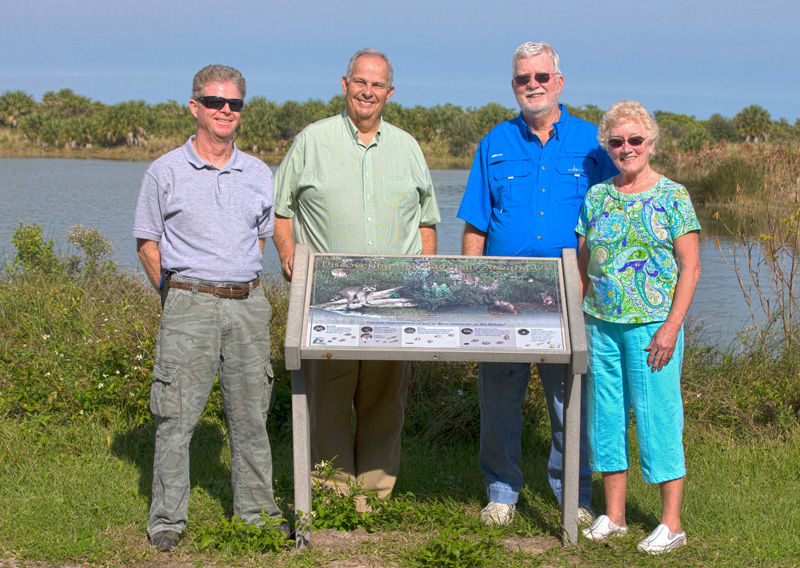The Pelican Island National Wildlife Refuge is a celebrated, even iconic place that has defined the Indian River Lagoon area for over a century. It’s that little mangrove island in the lagoon, which hundreds of birds call home and where humans aren’t allowed. Right? Not exactly. It’s actually much more than the familiar five-acre, bird-intensive, island rookery.
At this very moment, four friends – volunteers at the refuge – are organizing a brand-new support group whose mission is to bring greater awareness to the under-the-radar property, so that many more people might enjoy its natural wonders up close and personal. They’re calling it the Friends of Pelican Island Refuge (FOPIR).
Russ and Marilee Bell of Vero Beach and Jack Lampiasi and Doug Sutherland of Sebastian have spent the past couple of years becoming intimately familiar with the entire refuge. As they volunteered day after day in its unique ecosystem, the four came to clearly see the untapped potential for expanding public participation.
Accessed from A1A, north of Windsor on the Barrier Island, the Pelican Island National Wildlife Refuge stretches from slightly north of Wabasso Island to slightly south of Sebastian Inlet State Park’s Coconut Point.
Established as the first in the nation, the refuge today encompasses more than 5,000 acres of mangrove islands and submerged lands, and an amazing ecosystem with diverse habitats including seagrass beds, oyster bars, salt marsh, and maritime hammocks. In 1970, Pelican Island itself became the smallest wilderness area in the National Wilderness Preservation System, and in 1993 it was recognized as a Wetland of International Importance.
“The impetus for establishing this group was our observations that there needed to be support on the premises for interpretive activities at the Refuge,” Russ Bell explained.
“We think the Refuge is one of the (accidentally) best-kept secrets around! And,” he added with a grin, “We have all contracted Pelican Island Refuge Fever, which is highly contagious, with no cure.”
Thus was born FOPIR, its goal, “to provide a broader range of Refuge educational activities, events and programs; and broaden the awareness of the legacy in Sebastian, Indian River County and beyond.”
The four got busy right away. A federal 501(c)3 designation is currently in the works, as is the process of establishing a state non-profit status, both required to solicit donations.
Another vital element for the group’s success, said Bell, is building a strong board of directors, with each carefully chosen member bringing a specific area of expertise to the table – an architect, attorney, CPA, education/outreach professional, interpretation/curriculum design specialist, philanthropist, publicist/marketing person, school administrator, website/social media/database expert and fundraiser.
The Bells both bring significant experience to the endeavor, having served as officers on national and international levels for the Travel and Tourism Research Association International, and with the Marriott and Holiday Inn. In addition, they are Master Naturalists and Master Gardeners and have volunteered with other local environmental groups.
Because the Refuge is part of the U.S. Fish and Wildlife Service, a Memo of Understanding must be submitted to the service’s Refuge Management Team. When all requirements are met and a 2015 budget submitted, FOPIR can begin soliciting members and donations. Jan. 1, 2015, is the expected start-up date.
Meanwhile, the Bells, Tampiasi and Sutherland will continue working with other refuge volunteers, conducting free guided electric-train tours every Wednesday at 8 a.m. and tending to all the maintenance and repair tasks that the huge complex requires. The tours can accommodate 16 people at a time and reservations are required. Call 772-581-5557, ext. 2, and leave a message; someone will return your call.
Annual memberships will likely range from $10 for students to $100 for corporate memberships. Among current refuge needs, said Bell, are kids’ binoculars, butterfly nets, field guides, taxidermy mounts (for replicas, not real creatures), program supplies, kiosk refurbishment, bird replicas, signage, brochure design.
Future plans include a bookstore in the Cracker House on premises, a refuge-based Pioneer Festival in 2016, and additional handicap capabilities. The group also intends to work with existing organizations “to foster cooperative ventures for the benefit of the Refuge.” That includes the Pelican Island Preservation Society, a local environmental education organization which promotes awareness, primarily through its annual Pelican Island Wildlife Festival.
Bell and his pals hope Pelican Island Refuge Fever spreads quickly, with more residents coming on board to further the FOPIR mission: “to support and promote the rich conservation history of America’s first and most historic national wildlife refuge through outreach, environmental education and interpretation.”
For additional information contact the Bells at: FOPIR2014@gmail.com.

